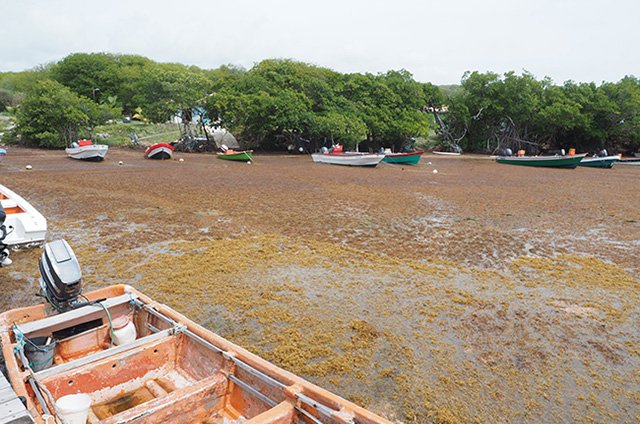Sargassum Inundation Events (SIEs): Impacts on the Economy
Related information in Spanish
Since 2011, the reoccurrence of massive Sargassum inundation events (SIEs) has hurt economies around the tropical Atlantic, Caribbean, and Gulf of America by forcing businesses and governments to incur costs associated with beach cleanup, and reducing commercial and recreational fishing, as well as tourism and recreation.
On this page:
Commercial and Recreational Fishing
SIEs may impact recreational and commercial fisheries by reducing the availability of important species and preventing fishermen from accessing and catching their target species. This can cause subsequent harm to local communities.
SIEs, both live and floating as well as those decomposing, can affect the availability and quality of aquatic species by limiting resources vital to photosynthesizing organisms, and impacting food sources, nursery areas, water quality, species growth, reproduction, and ultimately survival. Decomposing Sargassum blooms can kill recreational and commercially important species by releasing hydrogen sulfide and ammonia, reducing oxygen in the water, and by entanglement and suffocation.
Excessive Sargassum floating on the surface of the ocean or inundating shores can entangle fishing gear (such as nets and lines) and reduce access to fishing grounds,

leading to lower catch rates and reduced income. The influx of Sargassum can also cause fish behavior to change, making it more difficult to find and catch target species, resulting in fewer days at sea and lower profits. As a result, market changes, such as higher prices or changes in the availability of certain species, can also impact the profitability of fishing operations. All these factors can create a challenging environment for commercial and recreational fishing communities, particularly for small communities that rely heavily on fishing for their livelihoods.
Tourism and Recreation

SIEs lead to the accumulation of excessive algal biomass on beaches that has far-reaching impacts on tourism. Decomposing Sargassum can cause unsightly beaches and unpleasant odors, deterring tourists from visiting affected areas, resulting in decreased tourism revenue for local economies. Excess Sargassum can lead to reduced visitor arrivals due to restricted ocean access for leisure activities such as surfing, swimming, and snorkeling. In addition, authorities tend to close impacted beaches, causing repercussions to the broader tourism economy. The cleanup and disposal of Sargassum from these beaches is also costly and time consuming. Beach closures from excessive Sargassum have been reported from Cancún, Mexico to Key West, Florida, as well as in the Caribbean (Martinique; Guadeloupe; and the U.S. Virgin Islands).
Cleanup and Remediation

Removing Sargassum from beaches and preventing its aggregations from reaching beaches can present expensive challenges, particularly for small communities that have limited resources. The use of heavy machinery to remove Sargassum can also result in the loss of sand and contribute to beach erosion. In 2018, the estimated cost to clean up decomposing excessive Sargassum across the Caribbean was $120 million. In the United States, Miami-Dade County, Florida estimated $35 million dollars as the annual cost to collect, transport, and landfill Sargassum. A cost analysis by the city of Ft. Lauderdale, Florida, estimated an annual expenditure of $380,000 to clean beaches of Sargassum and maintain a Sargassum compost pile. In 2022, the U.S. Virgin Islands Department of Planning and Natural Resources Commissioner estimated the daily cost of removing dense inundation of decomposing Sargassum at $25,000 per day. That same year, the U.S. Virgin Islands declared a state of emergency as excessive accumulation of Sargassum onshore and in coastal waters obstructed the water intake of a desalination plant on St. Croix. As a result, the plant struggled to produce sufficient water to meet the demands of the area, particularly during the time of a prevailing drought.
References:
- Albeck-Ripka, L., & Schmall, E. (2023, March 14). A giant blob of seaweed is heading to Florida. The New York Times.
- Blare, T., Abdool-Ghany, A. A., & Solo-Gabriele, H. M. (2023). Cost estimates for producing Sargassum spp. compost. University of Florida IFAS.
- Bolton, D. (2015, August 10). Stinking seaweed on Caribbean beaches causes tourists to cancel holidays. The Independent.
- Coto, D. (2022, August 6). Seaweed clogs Caribbean's coasts. The Sunday Capital.
- Doyle, E., & Franks, J. (2015). Sargassum [Fact Sheet]. Gulf and Caribbean Fisheries Institute.
- Food and Agriculture Organization (FAO). (2019). Sargassum outbreaks in the Caribbean [Fact Sheet]. FAO of the United Nations, Subregional Office for the Caribbean, Hastings, Christ Church, Barbados.
- Marx, U. C., Roles, J., & Hankamer, B. (2021). Sargassum blooms in the Atlantic Ocean–From a burden to an asset. Algal Research, 54, 102188.
- Galoustian, G. (2021, May 24). Sargassum now world's largest harmful algal bloom due to nitrogen. Florida Atlantic University News Desk.
- George, E. (2022, July 19). Sargassum blooms cost $25,000 a day to remove from territory's shorelines, DPNR says as problem grows in USVI. The Virgin Islands Consortium.
- Smetacek, V., & Zingone, A. (2013). Green and golden seaweed tides on the rise. Nature, 504, 84-88.
- Stevenson, M. (2022, May 3). Mexico’s Caribbean beaches awash in foul-smelling Sargassum algae. Chicago Sun Times.
- Thompson, T. M., Ramin, P., Udugama, I., Young, B. R., Gernaey, K. V., & Baroutian, S. (2021). Techno-economic and environmental impact assessment of biogas production and fertiliser recovery from pelagic Sargassum: A biorefinery concept for Barbados. Energy Conversion and Management, 245, 114605.
